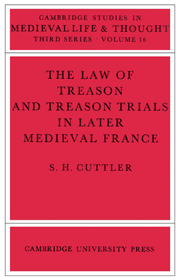Book contents
- Frontmatter
- Contents
- Dedication
- Preface
- Abbreviations
- Introduction
- 1 THE CONCEPT OF TREASON IN LATER MEDIEVAL FRANCE: LEGISTS, ‘COUTUMIERS’ AND TREATISE-WRITERS
- 2 THE CRIMES OF TREASON
- 3 JURISDICTION
- 4 PROCEDURE AND THE TRIAL OF PEERS
- 5 PUNISHMENT, FORFEITURE AND PARDON
- 6 TREASON AND THE CROWN 1328–1356
- 7 TREASON AND THE CROWN 1356–1380
- 8 TREASON AND THE CROWN 1380–1422
- 9 TREASON AND THE CROWN 1422–1461
- 10 TREASON AND THE CROWN 1461–1494
- Conclusion
- Bibliography
- Index
- Frontmatter
- Contents
- Dedication
- Preface
- Abbreviations
- Introduction
- 1 THE CONCEPT OF TREASON IN LATER MEDIEVAL FRANCE: LEGISTS, ‘COUTUMIERS’ AND TREATISE-WRITERS
- 2 THE CRIMES OF TREASON
- 3 JURISDICTION
- 4 PROCEDURE AND THE TRIAL OF PEERS
- 5 PUNISHMENT, FORFEITURE AND PARDON
- 6 TREASON AND THE CROWN 1328–1356
- 7 TREASON AND THE CROWN 1356–1380
- 8 TREASON AND THE CROWN 1380–1422
- 9 TREASON AND THE CROWN 1422–1461
- 10 TREASON AND THE CROWN 1461–1494
- Conclusion
- Bibliography
- Index
Summary
Unlike murder, rape, assault, theft or arson, treason is not easy to define, for it is conceived in abstract political terms. ‘Treason’, wrote Maitland, ‘is a crime which has a vague circumference and more than one centre.’ In later medieval France, although specific decrees identified specific offences as treasonable, there was never any precise delimitation of the crime, and what definition there was could be extended by construction. Treason was not just betrayal; it was an injury against public authority as represented by the person of the king and as symbolized by the crown. A felony yet more than a felony, treason was the political crime par excellence.
It is clear from even the most superficial reading that treason played a significant rôle in the history of later medieval France. The cases of Bernard Saisset, bishop of Pamiers, in 1301; Godefroi d'Harcourt in the 1340s; Jean de Montfort, duke of Brittany, in 1378; Jean de Montagu in 1409; Jean, duke of Alençon, in 1458; Louis de Luxembourg, count of Saint-Pol, in 1475; and Jacques d'Armagnac, duke of Nemours, in 1476–7 come readily to mind as examples. But it is not so much the treasons as the prosecution of them that will be of concern to us.
Some work, such as R. Guillot's exemplary monograph on the trial of Jacques Coeur in 1451–3, has been done on specific cases. At least one study, Mme Sylvie Troubert's doctorat de troisième cycle on the trial of Jacques d'Armagnac, is in progress. Much else, however, remains to be done in other individual cases.
- Type
- Chapter
- Information
- Publisher: Cambridge University PressPrint publication year: 1982

